Solar consumers are no longer asking if it is possible to power their lives with the sun, they are testing the limits of those possibilities. Just a couple years ago, we wrote a blog with the prophetic title, 48V Systems: The Future of Solar. Well, folks, the future is now!
Whether you are living in an RV, off grid cabin, or suburban neighborhood, you can power everything from lights and computers to residential refrigerators and air conditioners with energy from the sun.
How do you determine what size your system should be, which voltage you should choose, and which components you need? The questions all boil down to your daily energy needs, the types of appliances you want to run, the size of your solar array, and the amount of space you have available for both panels and batteries.
While most RVers can easily and inexpensively build a 12V panel and battery system that meets their basic DC and AC needs, folks with greater energy demands may find that a 24V system can help them run more powerful AC appliances. Going further, those who invest in a 48V system with enough solar panels and battery storage capacity, can even run electric heating and air conditioning!
Determining the Best Voltage for Your System
The greater your energy demand and the more powerful your appliances (especially if they heat or cool), the greater the current (amperage) flowing through your wiring. The greater the amperage, the larger the wiring has to be for safety – and, not surprisingly, larger wiring is more expensive.
Previously, with 12V systems, that meant adding more panels, larger capacity charge controllers, and huge battery banks, plus all that beefy wiring. Now, many solar consumers with higher energy demands are moving away from 12V and toward 24V and 48V systems for overall cost-space-benefit.
Looking at the basic Volts (V) x Amps (A) = Watts (W) equation, you can see how to achieve the same wattage by doubling the voltage of your overall system, thereby reducing the amperage by 50% at each step up in voltage.
For example, if we take a 1200W system and solve the equation for amps:
1200W / 12V = 100A
1200W / 24V = 50A
1200W / 48V = 25A
Overall, these higher voltage systems are not only safer, they are more cost effective, more efficient, weigh less, can be easier to build, and experience less transmission loss. The best news, the components, which were in production in 2020 when we wrote that prophetic article, are now readily available!
Before we proceed, below is some terminology in this article you’ll need to understand.
- Open Circuit Voltage = laboratory conditions for voltage
- Optimum Operating Voltage = typical real world conditions for voltage
- Optimum Operating Current = typical real world conditions for amperage
If you are brand new to solar, we encourage you to read our Unscrambling the Alphabet Soup of Solar Terminology blog for some additional help with terminology, as well as watch our Solar 101 video.
Choosing Components & Building a System
Once you have your head around some solar terminology, use our NEW Solar System Sizing Worksheet to calculate your energy needs, and determine the necessary size of your solar array, battery bank, and charge controller using the built-in solar calculator. The worksheet will then help you build a system and create an organized order for all of the components, wiring, accessories, and mounts that you will need. Our affiliate links in this blog, combined with our CANLIFE promo code, will save you 10% on all non-sale Renogy items – which can amount to hundreds of dollars in savings if you are building a larger system!
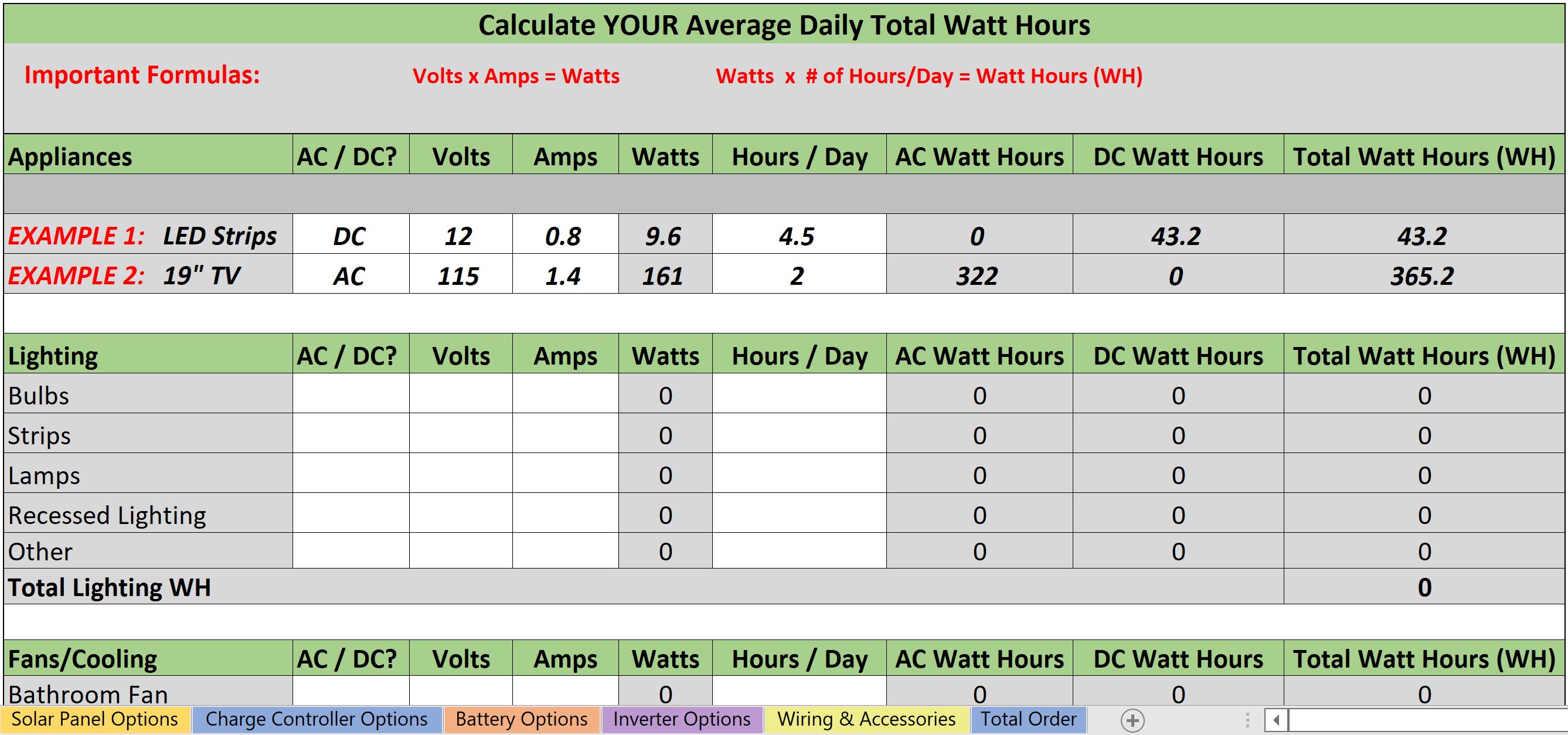
For the most cost-space-benefit, here’s a good rule of thumb that engineers use to determine the best voltage configuration for your system.
If your solar array capacity is:
- < 1000W then 12V is Good
- > 1000W and < 2000W then 24V is Better
- > 2000W then 48V is Best
Solar Panels
Solar panels operate at a higher voltage than batteries can accept to make up for the transmission loss along the wires and to produce enough energy on a low sun day for the batteries to still charge efficiently. The charge controller takes care of that extra voltage so that the battery gets what it needs. This can be a bit confusing because panels are sold as 12V or 24V, but that refers to its “nominal voltage” not the actual voltage it will produce. Since panels are sold as individual units, the nominal value indicates the voltage of the battery it can charge alone.
A single 100W panel can produce 20V (open circuit voltage), which is approximately 18V (optimum operating voltage), effectively charging a 12V battery bank, but not enough for a 24V battery. To charge this battery bank, you can either use a 24V (nominal) panel, or connect two smaller voltage panels in a series connection. Two 100W panels set up in series can produce 40V (open circuit voltage), and 36V (optimum operating voltage), producing enough voltage to effectively charge a 24V battery bank.
To build a 48V system without significantly increasing the amperage (and keeping your wiring smaller and cost lower), you can combine series and parallel connections together. A series configuration doubles the voltage and keeps the amperage the same.A parallel configuration doubles the amperage and keeps the voltage the same. By combining BOTH series and parallel connections within the same configuration, you can achieve the best of both worlds!
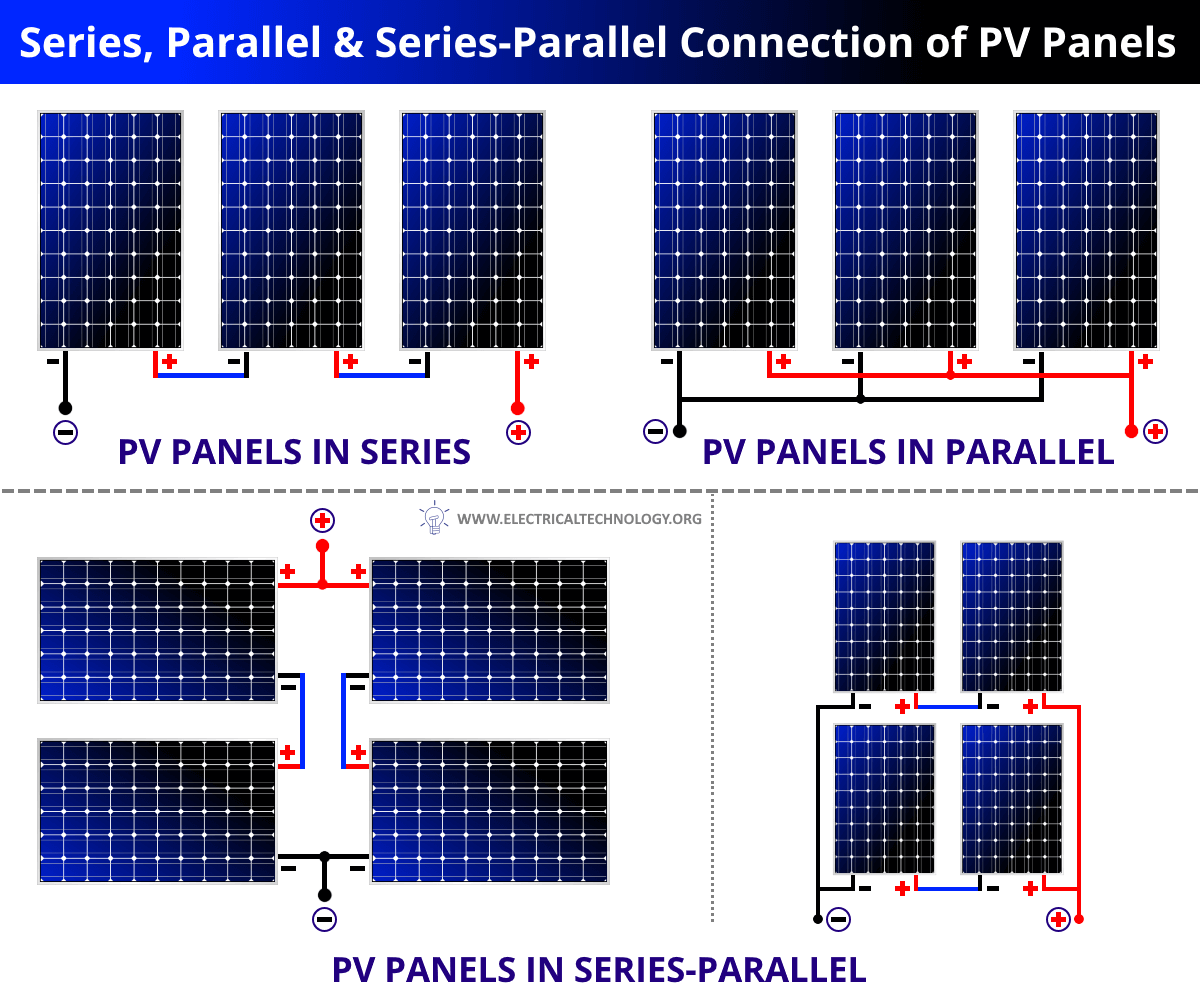
Below are some options for 12V, 24V, and 48V configurations, using Renogy 100W, 200W, and 320W panels. For each configuration, we calculate the voltage and amperage using a combination of series and parallel connections and indicate the voltage and current produced. As you can see from the chart, you can easily create a sizable 48V system, while keeping the amperage moderately low (40A)! Note: For sake of example, specific numbers in the chart are rounded to the nearest decimal. See the Renogy website for exact specifications for each product.

*Two 100W panels connected in series, then each of the 4 “series pairs” connected in parallel. (100W+100W)=(100W+100W)=(100W+100W)=(100W+100W)
**Two 200W panels connected in series, then each of the 4 “series pairs” connected in parallel. (200W+200W)=(200W+200W)=(200W+200W)=(200W+200W)
***Two 3200W panels connected in series, then each of the 4 “series pairs” connected in parallel. (320W+320W)=(320W+320W)=(320W+320W)=(320W+320W)
Note: The above configurations with specific panels and connections in series or parallel are just a few examples of the many ways to reach the desired wattage of your system. Space, weight, location specifications for panels, and wiring distance all play a part in determining the best way to configure your solar array.
Charge Controllers
For a quick moment, let’s review the two different types of charge controllers – PWM and MPPT.
PWM serves as a simple on/off switch that monitors the charge coming in from the solar panels. When using a PWM charge controller, the nominal voltage of the panel array needs to match the voltage of the battery bank.
MPPT charge controllers are more complex, making them more flexible and efficient. These controllers can charge a 12V battery bank with a panel array ranging from 12V to 48V (assuming the array does not go over the PV voltage limit). With MPPT, the total array voltage needs to be greater than the battery bank voltage, but it also uses that extra voltage to boost the amperage going to your battery.
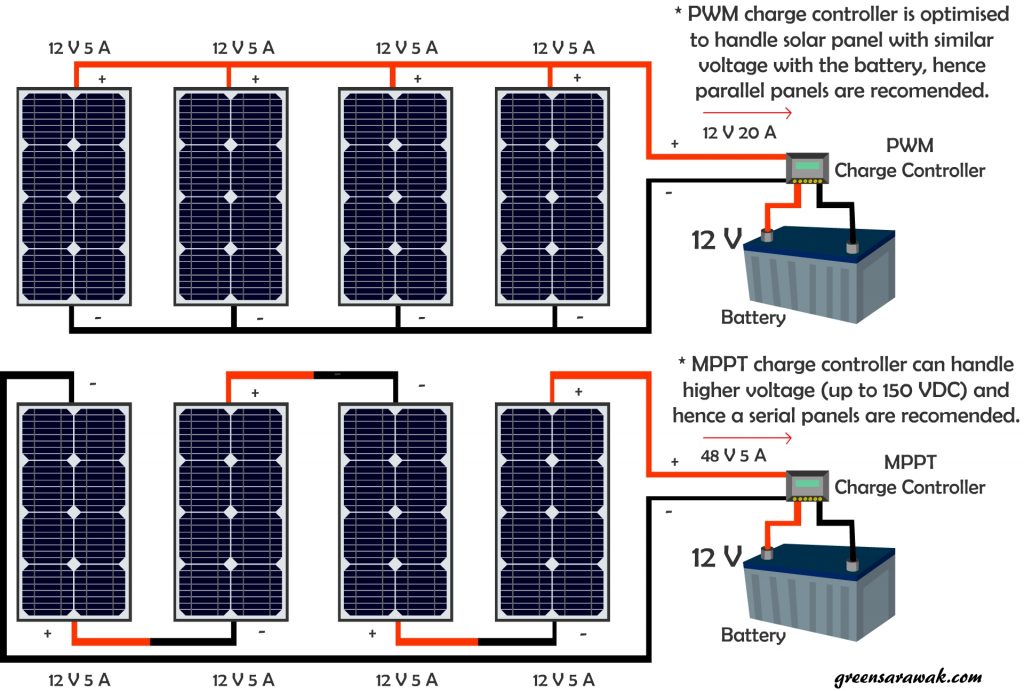
The following Renogy charge controllers are designed to work with 12V, 24V, or 48V systems.
The Rover 60A and 100A will work with any of these system options, while the Wanderer 10A, Adventurer Li 30A, Voyager 10A and 20A, Rover Li 20A, 30A, and 40A, and Rover Elite 20A and 40A will work with either 12V or 24V. The new Rover Boost 10A* is a unique charge controller which boosts the voltage of 12V or 24V panels to charge 48V (or 36V) batteries.
Choosing the correct one for your system requires that you know both your panel array size so that you can determine your overall amperage, as well as the type of deep cycle batteries you will be using (Gel, AGM, LFP) – not all charge controllers work with all battery types.

*This unique charge controller boosts the voltage of 12V or 24V panels to charge 48V (or 36V) batteries.
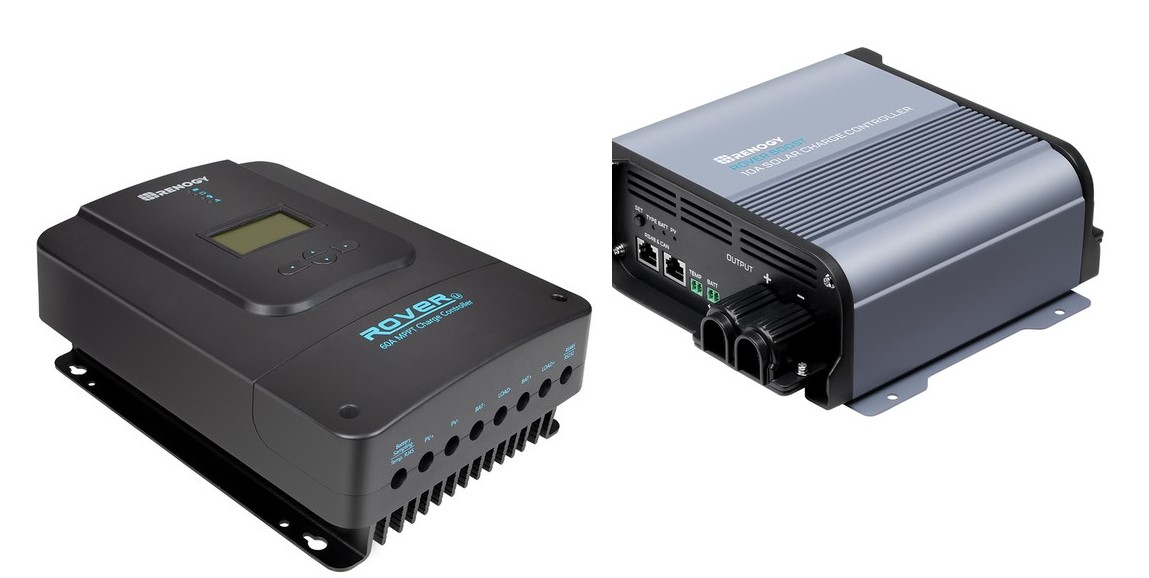
Higher Voltage Solar Kits
Renogy takes some of the guesswork out of combining panels and charge controllers with their popular solar kits (ranging from 12V to 48V packages) which include many of the components and accessories you will need such as BT module, branch connectors, wiring, mounting brackets, breakers, breaker box, etc. Each kit is slightly different, so be sure to check out what’s included in the kit you choose!
These newer, 24V and 48V kits include:
24V – 600W Premium Kit includes a Rover Li 40A
24V – 800W Premium Kit includes a Rover Li 40A
48V – 2500W Kit includes the MidNite Classic Charge Controller (chose from basic, deluxe, and premium kits)
48V – 4800W Kit includes the MidNite Classic Charge Controller 150VDC (chose from basic, deluxe, and premium kits)
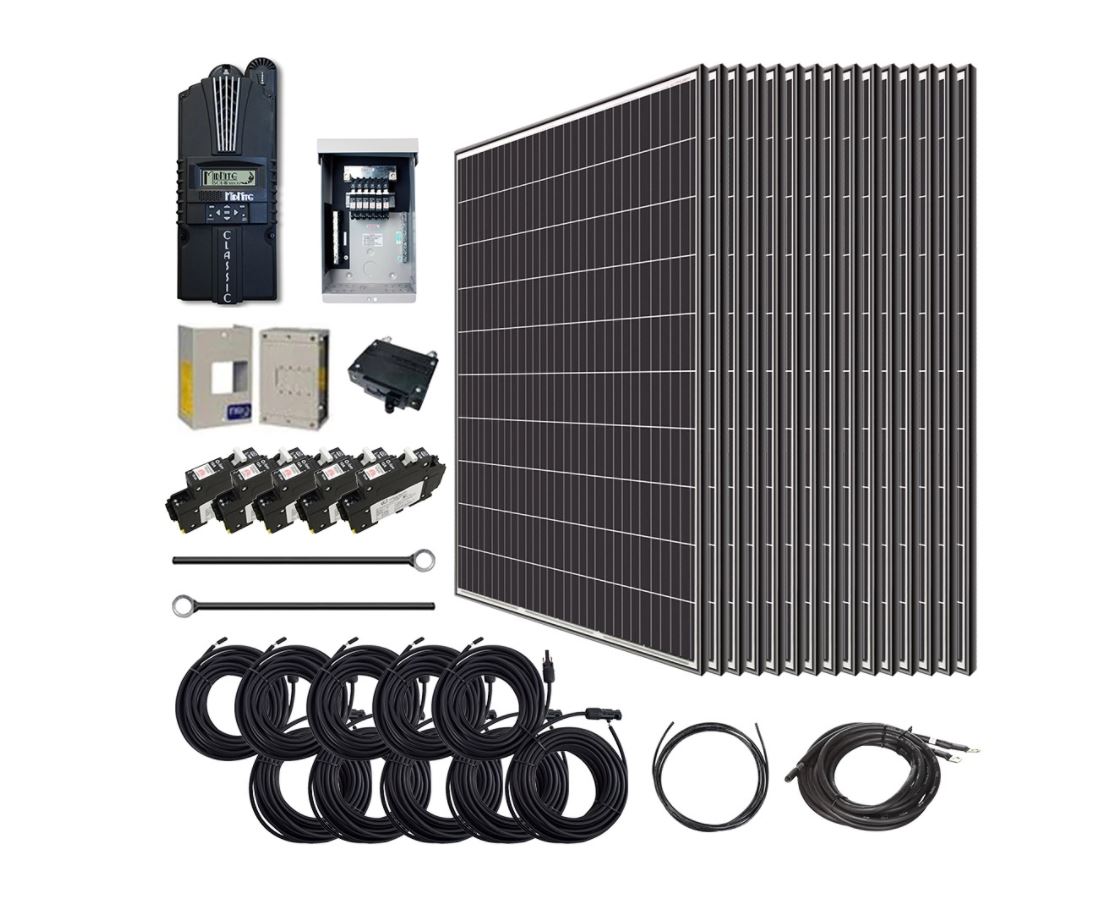
Deep Cycle Batteries
The same series-parallel configuration we discussed withSolar Panels can be applied to batteries. Connect batteries in series to double the voltage, and keep the amperage the same, in parallel you double the amperage, and keep the voltage the same. Only traditional Lead Acid, Gel or AGM batteries can be put in series; Lithium Iron Phosphate batteries can only connect in parallel.

To build a 24V battery bank, you need to combine two 12V AGM batteries -OR- two 12V Gel batteries in series – both come in either 100Ah or 200Ah models.Gel and AGM will typically last 500-750 cycles. When put in series, two Hybrid Gel 100Ah batteries will produce 24V and give you 2400 watt hours, with a usable 1200 watt hours (using a safe 50% depth of discharge). Or, combining two AGM 200Ah batteries will produce 24V and give you 4800 watt hours, with a usable 2400 usable watt hours (using a safe 50% depth of discharge).

To build a 48V battery bank, simply connect 4 Gel -OR- AGM batteries in series. Something to consider is that this combination is very heavy! Four 100Ah Gel or AGM batteries weigh in at 256 pounds, and four of the 200Ah models weigh 512 pounds! A lighter weight, very efficient option for a higher voltage system is Renogy’s 48V 50Ah Lithium Iron Phosphate battery. This battery is designed to last 4500 cycles (6-9 times longer than AGM or Gel), has a self-heating function for charging in chilly temps, and can produce 2400 watt hours per cycle, with a usable 1920 watt hours (using a safe 80% depth of discharge). Note: The 100Ah and 200Ah Lithium Iron Phosphate batteries listed below are provided for sake of example but CANNOT be connected in series; they must remain alone or in parallel. Therefore, you CANNOT use these batteries to create a 24 or 48V system.

Inverters
The whole point of a higher voltage system is to be able to run higher wattage AC appliances without over-wiring the whole system. To do this, you need to connect an inverter to the battery bank. It is important to match the battery bank voltage with an inverter that can handle that same voltage. Simply put, if you have a 12V system, you need a 12V inverter; a 48V system requires a 48V inverter.
Standard Pure Sine Wave inverters simply change DC power to AC power. Inverter Chargers handle this function plus allow you to charge your batteries off shore power or a generator. Renogy’s 3500W Solar Inverter Chargeris designed for a 48V system. This all-in-one component is the best of both worlds AND combines an 80A MPPT Charge Controller, thus eliminating the need for an additional controller. Note: Renogy does not currently offer a 24V inverter at this time.
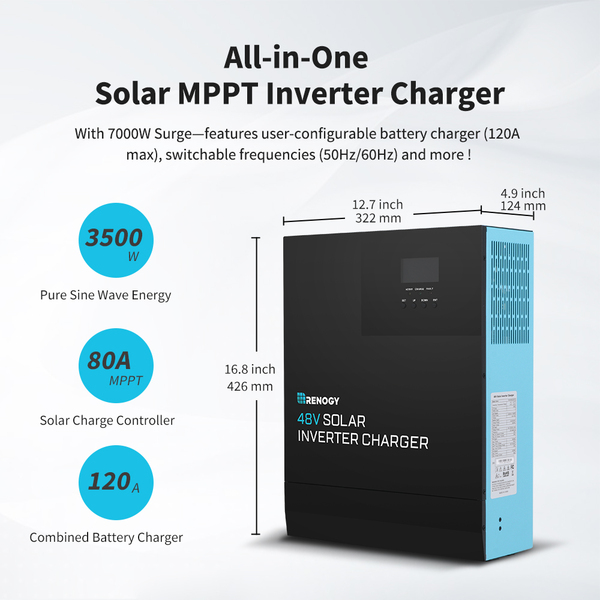

Special Consideration for 24V & 48V systems
In order to run 12V DC appliances from a 24V or 48V system, you need a 48V to 12V or 24V to 12V step down converter unless the appliances are variable voltage which is still a bit rare at present – though we predict that more and more will be available in the future – let’s see if we are right!
Believe us, we know how much there is to consider when you start considering solar power. With so many new products designed to integrate together and take away the guesswork, there’s never been more resources to help you dive into that solar future now.
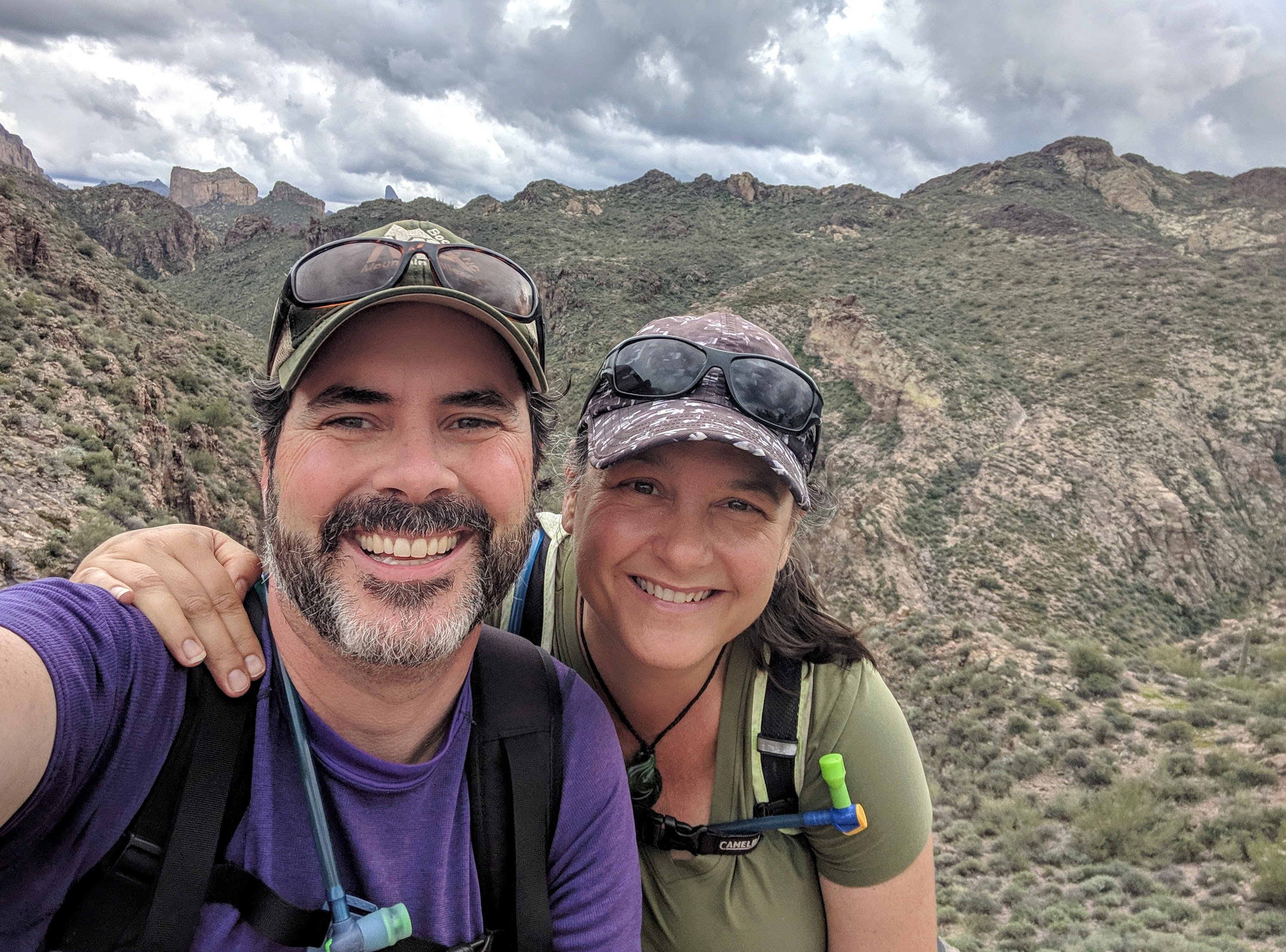
In 2012, Shari Galiardi & David Hutchison left behind careers and a comfortable home in North Carolina to travel with the vintage camper trailer they lovingly restored, outfitted with solar, and named “Hamlet.” What began as a short break from careers and responsibility quickly turned into a love affair with roadlife. They have parlayed their higher education backgrounds, desire for life-long learning, and thirst for adventure travel into writing, photography, video production, and public speaking gigs from coast to coast. Known to their friends as simply Shari & Hutch, you can learn more about their full-time, solar-powered adventures on their website at freedominacan.com. Or, follow them on Facebook, Instagram, and YouTube as “Freedom in a Can, LLC.” Note: All links contained within this blog contain affiliate links provided by Freedom in a Can.






